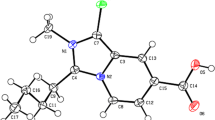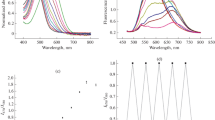Abstract
Cellular pH homeostasis is essential for many physiological and pathological processes. pH monitoring is helpful for the diagnosis, treatment and prevention of disorders and diseases. Herein, we developed a ratiometric fluorescent pH probe (TCC) based on a coumarin derivative containing a highly active lactone ring. TCC exhibited a typical AIE effect and emitted blue fluorescence under weak acidic condition. When under weak basic condition, the active lactone moiety underwent a hydrolysis reaction to afford a water-soluble product, which gave red-shifted emission. The emission color change from blue through cyan and then to yellow within pH 6.5–9.0 which is approximate to the biological pH range. And the fluorescence color change along with pH value is reversible. Furthermore, TCC was successfully utilized in the detection of the intracellular pH change of live HeLa cells, which indicated that TCC had practical potential in biomedical research.







Similar content being viewed by others
Availability of data and material
/ Data availability The crystallographic information files that have been deposited in the Cambridge Crystallographic Data Centre (CCDC 2,131,284) which are freely available for all. The link for CCDC: https://www.ccdc.cam.ac.uk/.
Code Availability
not applicable.
References
Lagadic-Gossmann D, Huc L, Lecureur V (2004) Alterations of intracellular pH homeostasis in apoptosis: origins and roles. Cell Death Differ 11:953–961. https://doi.org/10.1038/sj.cdd.4401466
Donoso P, Beltrán M, Hidalgo C (1996) Luminal pH regulates calcium release kinetics in sarcoplasmic reticulum vesicles. Biochemistry 35:13419–13425. https://doi.org/10.1021/bi9616209
Neuhoff S, Ungell AL, Zamora I, Artursson P (2003) pH-dependent bidirectional transport of weakly basic drugs across Caco-2 monolayers: implications for drug-drug interactions. Pharm Res 20:1141–1148. https://doi.org/10.1023/A:1025032511040
Kullas AL, Martin SJ, Davis D (2007) Adaptation to environmental pH: integrating the Rim101 and calcineurin signal transduction pathways. Mol Microbiol 66:858–871. https://doi.org/10.1111/j.1365-2958.2007.05929.x
Wen Y, Zhang W, Liu T, Huo F, Yin C (2017) Pinpoint diagnostic kit for heat stroke by monitoring lysosomal pH. Anal Chem 89:11869–11874. https://doi.org/10.1021/acs.analchem.7b03612
Davies TA, Fine RE, Johnson RJ, Levesque CA, Rathbun WH, Seetoo KF, Smith SJ, Strohmeier G, Volicer L, Delva L (1993) Non-age related differences in thrombin responses by platelets from male patients with advanced Alzheimer’s disease. Biochem Biophys Res Commun 194:537–543. https://doi.org/10.1006/bbrc.1993.1853
White KA, Grillo-Hill BK, Barber DL (2017) Cancer cell behaviors mediated by dysregulated pH dynamics at a glance. J Cell Sci 130:663–669. https://doi.org/10.1242/jcs.195297
Chao J, Liu Y, Sun J, Fan L, Zhang Y, Tong H, Li Z (2015) A ratiometric pH probe for intracellular pH imaging. Sens Actuat B-Chem 221:427–433. https://doi.org/10.1016/j.snb.2015.06.087
Chen S, Qiu R, Yu Q, zhang X, Wei M, Dai Z (2018) Boranil dyes bearing tetraphenylethene: synthesis, AIE/AIEE effect properties, pH sensitive properties and application in live cell imaging. Tetra Lett 59:2671–2678. https://doi.org/10.1016/j.tetlet.2018.05.081
Lin B, Wei Y, Hao Y, Shuang E, Shu Y, Wang J (2021) β-Naphthothiazolium-based ratiometric fluorescent probe with ideal pKa for pH imaging in mitochondria of living cells. Talanta 232:122475. https://doi.org/10.1016/j.talanta.2021.122475
Wang J, Liu H, Wu M, Liu X, Sun H, Zheng A (2019) Water-soluble organic probe for pH sensing and imaging. Talanta 205:120095. https://doi.org/10.1016/j.talanta.2019.06.095
Qian J, Tang BZ (2017) AIE luminogens for bioimaging and theranostics: from organelles to animals. Chem 3:56–91. https://doi.org/10.1016/j.chempr.2017.05.010
Mukherjee A, Saha PC, Das RS, Bera T, Guha S (2021) Acidic pH-activatable visible to near-infrared switchable ratiometric fluorescent probe for live-cell lysosome targeted imaging. ACS Sens 6:2141–2146. https://doi.org/10.1021/acssensors.1c00961
Zhang XF, Zhang T, Shen SL, Miao JY, Zhao BX (2015) A ratiometric lysosomal pH probe based on the naphthalimide–rhodamine system. J Mater Chem B 3:3260–3266. https://doi.org/10.1039/C4TB02082K
Jiao Y, Gong X, Han H, Gao Y, Lu W, Liu Y, Xian M, Shuang S, Dong C (2018) Facile synthesis of orange fluorescence carbon dots with excitation independent emission for pH sensing and cellular imaging. Anal Chim Acta 1042:125–132. https://doi.org/10.1016/j.aca.2018.08.044
Yao S, Schafer-Hales KJ, Belfield KD (2007) A new water-soluble near-neutral ratiometric fluorescent pH indicator. Org Lett 9:5645–5648. https://doi.org/10.1021/ol7026366
Yang SL, Liu WS, Li G, Bu R, Li P, Gao EQ (2020) A pH-sensing fluorescent metal-organic framework: pH-triggered fluorescence transition and detection of mycotoxin. Inorg Chem 59:15421–15429. https://doi.org/10.1021/acs.inorgchem.0c02419
Liu T, Yan B (2020) A stable broad-range fluorescent pH sensor based on Eu3+ post-synthetic modification of metal-organic framework. Ind Eng Chem Res 59:1764–1771. https://doi.org/10.1021/acs.iecr.9b06292
Liu W, Sun R, Ge JF, Xu YJ, Xu Y, Lu JM, Itoh I, Ihara M (2013) Reversible near-infrared pH probes based on benzo[a]phenoxazine. Anal Chem 85:7419–7425. https://doi.org/10.1021/ac4013539
Alamry KA, Georgiev NI, El-Daly SA, Taib LA, Bojinov VB (2015) A highly selective ratiometric fluorescent pH probe based on a PAMAM wavelength-shifting bichromophoric system. Spectrochim Acta A 135:792–800. https://doi.org/10.1016/j.saa.2014.07.076
Ryan LS, Gerberich J, Haris U, Nguyen D, Mason RP, Lippert AR (2020) Ratiometric pH imaging using a 1,2-dioxetane chemiluminescence resonance energy transfer sensor in live animals. ACS Sens 5:2925–2932. https://doi.org/10.1021/acssensors.0c01393
Feng Q, Li Y, Wang L, Li C, Wang J, Liu Y, Li K, Hou H (2016) Multiple-color aggregation-induced emission (AIE) molecules as chemodosimeters for pH sensing. Chem Commun 52:3123–3126. https://doi.org/10.1039/C5CC10423H
Wen Y, Zhang W, Liu T, Huo F, Yin C (2017) A pinpoint diagnostic kit for heat stroke by monitoring lysosomal pH. Anal Chem 89:11869–11874. https://doi.org/10.1021/acs.analchem.7b03612
Lin B, Fan L, Ying Z, Ge J, Wang X, Zhang T, Dong C, Shuang S, Wong MS (2020) The ratiometric fluorescent probe with high quantum yield for quantitative imaging of intracellular pH. Talanta 208:120279. https://doi.org/10.1016/j.talanta.2019.120279
Cao L, Li X, Wang S, Li S, Li Y, Yang G (2014) A novel nanogel-based fluorescent probe for ratiometric detection of intracellular pH values. Chem Commun 50:8787–8790. https://doi.org/10.1039/C4CC03716B
WangY, Zeng L, Zhou J, Jiang B, Zhao L, Wang C, Xu B (2019) A dansyl fluorescent pH probe with wide responsive range in aqueous solution. Spectrochim Acta A 223:117348. https://doi.org/10.1016/j.saa.2019.117348
Qiu J, Jiang S, Guo H, Yang F (2018) An AIE and FRET-based BODIPY sensor with large Stoke shift: novel pH probe exhibiting application in CO32– detection and living cell imaging. Dyes Pigm 157:351–358. https://doi.org/10.1016/j.dyepig.2018.05.013
Peng H, Stolwijk JA, Sun LN, Wegener J, Wolfbeis OS (2010) A nanogel for ratiometric fluorescent sensing of intracellular pH values. Angew Chem Int Ed 49:4246–4249. https://doi.org/10.1002/anie.200906926
Yang Z, Qin W, Lam JWY, Chen S, Sung HHY, Williams ID, Tang BZ (2013) Fluorescent pH sensor constructed from a heteroatom-containing luminogen with tunable AIE and ICT Characteristics. Chem Sci 4:3725–3730. https://doi.org/10.1039/C3SC50648G
Wang X, Wang H, Niu Y, Wang Y, Feng L (2020) A facile AIE fluorescent probe for broad range of pH detection. Spectrochim Acta A 226:117650. https://doi.org/10.1016/j.saa.2019.117650
Shi X, Yan N, Niu G, Sung SHP, Liu Z, Liu J, Kwok RTK, Lam JWY, Wang WX, Sung HHY, Williams ID, Tang BZ In vivo monitoring of tissue regeneration using a ratiometric lysosomal AIE probe.Chem Sci11:3152–3163. https://doi.org/10.1039/C9SC06226B
Shi L, Liu Y, Wang Q, Wang T, Ding Y, Cao Y, Li Z, Wei H (2018) A pH responsive AIE probe for enzyme assays. Analyst 143:741–746. https://doi.org/10.1039/C7AN01710C
Leung CWT, Hong Y, Chen S, Zhao E, Lam JWY, Tang BZ (2013) A photostable AIE luminogen for specific mitochondrial imaging and tracking. J Am Chem Soc 135:62–65. https://doi.org/10.1021/ja310324q
Long Z, Liu M, Jiang R, Wan Q, Mao L, Wan Y, Deng F, Zhang X, Wei Y (2017) Preparation of water soluble and biocompatible AIE-active fluorescent organic nanoparticles via multicomponent reaction and their biological imaging capability. Chem Eng J 308:527–534. https://doi.org/10.1016/j.cej.2016.09.053
Wang D, Qian J, Qin W, Qin A, Tang BZ, He S (2014) Biocompatible and photostable AIE dots with red emission for in vivo two-photon bioimaging. Sci Rep 4:4279. https://doi.org/10.1038/srep04279
Sayed SM, Jia HR, Jiang YW, Zhu YX, Ma L, Sayed SM, Jia HR, Jiang YW, Zhu YX, Ma L, Yin F, Hussain I, Khan A, Ma Q, Wu FG, Lu X (2021) Photostable AIE probes for wash-free, ultrafast, and high-quality plasma membrane staining. J Mater Chem B 9:4303–4308. https://doi.org/10.1039/D1TB00049G
Feng G, Liu B (2018) Aggregation-induced emission (AIE) dots: emerging theranostic nanolights. Acc Chem Res 51:1404–1414. https://doi.org/10.1021/acs.accounts.8b00060
Lakshmi PR, Kumar PS, Elango KP (2020) A simple fluorophore-imine ensemble for colorimetric and fluorescent detection of CN– and HS– in aqueous solution. Spectrochim Acta A 229:117974. https://doi.org/10.1016/j.saa.2019.117974
Funding
This work is financially supported by Hainan Provincial Natural Science Foundation of China (222MS059), the National Natural Science Foundation of China (22061016) and Program for Innovative Research Team in University (IRT-16R19).
Author information
Authors and Affiliations
Contributions
EW contributed to the study conception and design, and was the major contributor in writing the manuscript. The synthesis, spectrum test, data analysis and so on were performed by QL with the assistance of XN. The X-ray diffraction data collection and structure determination was performed by ZN.
Corresponding author
Ethics declarations
Conflicts of Interest/Competing interests
The authors have no conflicts of interest to declare that are relevant to the content of this article.
Ethical approval
Not applicable.
Consent to participate
Not applicable.
Consent for publication
Not applicable.
Additional information
Publisher’s note
Springer Nature remains neutral with regard to jurisdictional claims in published maps and institutional affiliations.
Electronic supplementary material
Below is the link to the electronic supplementary material.
Rights and permissions
About this article
Cite this article
Li, Q., Niu, Z., Nan, X. et al. An AIE-Active probe for detection and bioimaging of pH values based on lactone hydrolysis reaction. J Fluoresc 32, 1611–1617 (2022). https://doi.org/10.1007/s10895-022-02967-6
Received:
Accepted:
Published:
Issue Date:
DOI: https://doi.org/10.1007/s10895-022-02967-6




